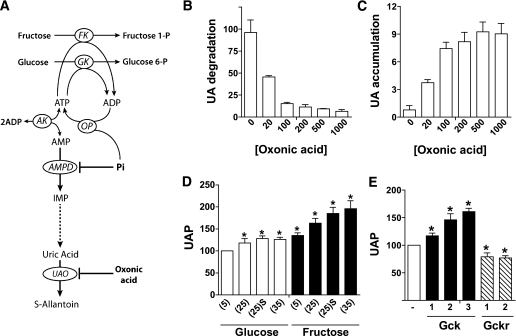FIG. 8.
Glucose metabolism affects uric acid production by hepatocytes. A: Uric acid is the final product of purine degradation in humans because of lack of a functional urate oxidase (UAO) gene. In other mammals, uric acid is further metabolized to S-allantoin by urate oxidase. AMP-deaminase (AMPD) catalyses the conversion of AMP to inosine monophosphate and is inhibited by physiological concentrations of Pi. During ATP-dependent phosphorylation of fructose or glucose, the ADP generated at the level of fructokinase (FK) or glucokinase (GK) is reconverted to ATP by oxidative phosphorylation (OP). If accumulation of phosphorylated intermediates during sugar metabolism causes depletion of Pi, then AMPD is deinhibited, resulting in degradation of AMP to uric acid. B: Oxonic acid inhibits uric acid degradation. Rat hepatocytes were incubated for 30 or 60 min in medium containing 100 μmol/L uric acid and the concentrations of oxonic acid (μmol/L) shown. Uric degradation is expressed as nmol/h per mg protein. C: Effects of oxonic acid on uric acid accumulation in the medium (nmol/h per mg) during incubation of hepatocytes in medium containing 30 mmol/L fructose and the oxonic acid concentrations (μmol/L) indicated. D: Effects of glucose and fructose on uric acid production (UAP, expressed as % control) in hepatocytes incubated for 1 h in medium containing 500 μmol/L oxonic acid and the substrates indicated (5, 25, or 35 mmol/L substrate or 25 mmol/L substrate + S4048 [(25)S]). E: Uric acid production (expressed as % control) in hepatocytes treated with adenoviral vectors for overexpression of Gck (2.5 to 10-fold) or Gckr (four- to sixfold) and incubated for 1 h in medium containing 25 mmol/L glucose. Means ± SEM, n = 3 (B and C); n = 3–7 (D and E). *P < 0.05 relative to 5 mmol/L glucose (D) or relative to untreated (E).

